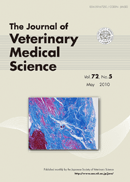Volume 72, Issue 5
May
Displaying 1-26 of 26 articles from this issue
- |<
- <
- 1
- >
- >|
Anatomy
-
Article type: FULL PAPER
2010Volume 72Issue 5 Pages 555-560
Published: 2010
Released on J-STAGE: June 04, 2010
Advance online publication: January 08, 2010Download PDF (881K) -
Article type: FULL PAPER
2010Volume 72Issue 5 Pages 605-609
Published: 2010
Released on J-STAGE: June 04, 2010
Advance online publication: January 26, 2010Download PDF (752K)
Bacteriology
-
Article type: FULL PAPER
2010Volume 72Issue 5 Pages 589-597
Published: 2010
Released on J-STAGE: June 04, 2010
Advance online publication: January 26, 2010Download PDF (720K) -
Article type: NOTE
2010Volume 72Issue 5 Pages 611-614
Published: 2010
Released on J-STAGE: June 04, 2010
Advance online publication: December 15, 2009Download PDF (665K) -
Article type: NOTE
2010Volume 72Issue 5 Pages 621-625
Published: 2010
Released on J-STAGE: June 04, 2010
Advance online publication: December 15, 2009Download PDF (851K) -
Article type: NOTE
2010Volume 72Issue 5 Pages 647-652
Published: 2010
Released on J-STAGE: June 04, 2010
Advance online publication: January 13, 2010Download PDF (659K) -
Article type: NOTE
2010Volume 72Issue 5 Pages 653-655
Published: 2010
Released on J-STAGE: June 04, 2010
Advance online publication: January 13, 2010Download PDF (733K)
Clinical Pathology
-
Article type: FULL PAPER
2010Volume 72Issue 5 Pages 533-537
Published: 2010
Released on J-STAGE: June 04, 2010
Advance online publication: December 15, 2009Download PDF (885K) -
Article type: NOTE
2010Volume 72Issue 5 Pages 673-677
Published: 2010
Released on J-STAGE: June 04, 2010
Advance online publication: January 22, 2010Download PDF (874K)
Ethology
-
Article type: FULL PAPER
2010Volume 72Issue 5 Pages 539-545
Published: 2010
Released on J-STAGE: June 04, 2010
Advance online publication: December 16, 2009Download PDF (593K)
Internal Medicine
-
Article type: FULL PAPER
2010Volume 72Issue 5 Pages 547-553
Published: 2010
Released on J-STAGE: June 04, 2010
Advance online publication: December 25, 2009Download PDF (648K) -
Article type: NOTE
2010Volume 72Issue 5 Pages 615-619
Published: 2010
Released on J-STAGE: June 04, 2010
Advance online publication: December 15, 2009Download PDF (919K)
Laboratory Animal Science
-
Article type: FULL PAPER
2010Volume 72Issue 5 Pages 583-587
Published: 2010
Released on J-STAGE: June 04, 2010
Advance online publication: January 26, 2010Download PDF (629K)
Parasitology
-
Article type: FULL PAPER
2010Volume 72Issue 5 Pages 599-604
Published: 2010
Released on J-STAGE: June 04, 2010
Advance online publication: January 26, 2010Download PDF (682K)
Pathology
-
Article type: NOTE
2010Volume 72Issue 5 Pages 639-642
Published: 2010
Released on J-STAGE: June 04, 2010
Advance online publication: January 08, 2010Download PDF (922K) -
Article type: NOTE
2010Volume 72Issue 5 Pages 657-659
Published: 2010
Released on J-STAGE: June 04, 2010
Advance online publication: January 15, 2010Download PDF (993K) -
Article type: NOTE
2010Volume 72Issue 5 Pages 661-664
Published: 2010
Released on J-STAGE: June 04, 2010
Advance online publication: January 15, 2010Download PDF (726K) -
Article type: NOTE
2010Volume 72Issue 5 Pages 665-668
Published: 2010
Released on J-STAGE: June 04, 2010
Advance online publication: January 20, 2010Download PDF (722K) -
Article type: NOTE
2010Volume 72Issue 5 Pages 669-671
Published: 2010
Released on J-STAGE: June 04, 2010
Advance online publication: January 22, 2010Download PDF (717K)
Public Health
-
Article type: NOTE
2010Volume 72Issue 5 Pages 643-645
Published: 2010
Released on J-STAGE: June 04, 2010
Advance online publication: January 13, 2010Download PDF (499K)
Surgery
-
Article type: FULL PAPER
2010Volume 72Issue 5 Pages 575-581
Published: 2010
Released on J-STAGE: June 04, 2010
Advance online publication: January 20, 2010Download PDF (762K)
Theriogenology
-
Article type: NOTE
2010Volume 72Issue 5 Pages 627-629
Published: 2010
Released on J-STAGE: June 04, 2010
Advance online publication: December 22, 2009Download PDF (543K)
Toxicology
-
Article type: FULL PAPER
2010Volume 72Issue 5 Pages 561-566
Published: 2010
Released on J-STAGE: June 04, 2010
Advance online publication: January 13, 2010Download PDF (652K) -
Article type: FULL PAPER
2010Volume 72Issue 5 Pages 567-573
Published: 2010
Released on J-STAGE: June 04, 2010
Advance online publication: January 13, 2010Download PDF (947K)
Virology
-
Article type: NOTE
2010Volume 72Issue 5 Pages 631-634
Published: 2010
Released on J-STAGE: June 04, 2010
Advance online publication: December 25, 2009Download PDF (717K) -
Article type: NOTE
2010Volume 72Issue 5 Pages 635-638
Published: 2010
Released on J-STAGE: June 04, 2010
Advance online publication: January 08, 2010Download PDF (496K)
- |<
- <
- 1
- >
- >|
